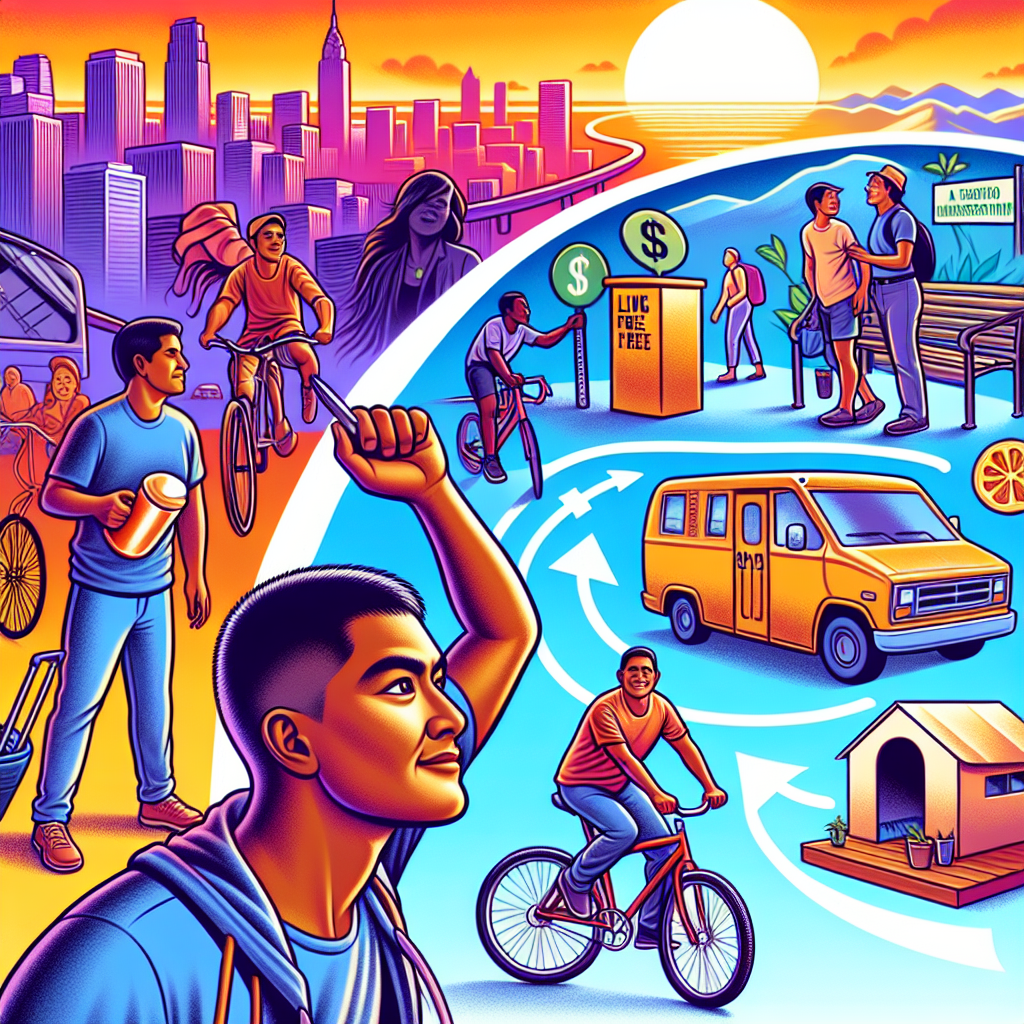-
Table of Contents
- My Path to Zero Housing and Transportation Expenses: Living Rent-Free and Car-Free
- The Rising Cost of Living
- Living Rent-Free: Strategies and Examples
- House Hacking
- Living with Family or Friends
- Work Exchange Programs
- Living Car-Free: Strategies and Examples
- Public Transportation
- Biking and Walking
- Car Sharing and Ride-Hailing Services
- Case Studies: Real-Life Examples
- Case Study 1: The Minimalists
- Case Study 2: Mr. Money Mustache
- Statistics: The Benefits of Living Rent-Free and Car-Free
- Challenges and Considerations
- Conclusion
My Path to Zero Housing and Transportation Expenses: Living Rent-Free and Car-Free

In an era where the cost of living continues to rise, finding ways to minimize expenses is more crucial than ever. Housing and transportation are two of the most significant financial burdens for most people. However, it is possible to live rent-free and car-free, drastically reducing these costs. This article explores my journey to achieving zero housing and transportation expenses, providing valuable insights, examples, and strategies for those looking to follow a similar path.
The Rising Cost of Living
The cost of living has been steadily increasing over the years. According to the U.S. Bureau of Labor Statistics, the Consumer Price Index (CPI) for all urban consumers rose by 5.4% from June 2020 to June 2021. Housing and transportation are two of the largest components of the CPI, making up a significant portion of household expenses.
For many, these costs can be overwhelming. The average American spends about 33% of their income on housing and 16% on transportation, according to the U.S. Bureau of Labor Statistics. This leaves little room for savings or other essential expenses. However, by adopting a rent-free and car-free lifestyle, it is possible to significantly reduce these costs and achieve financial freedom.
Living Rent-Free: Strategies and Examples
House Hacking
House hacking is a popular strategy for living rent-free. This involves purchasing a multi-family property, living in one unit, and renting out the others. The rental income from the other units can cover the mortgage and other housing expenses, allowing you to live rent-free.
For example, consider the case of Brandon Turner, a real estate investor and co-host of the BiggerPockets Podcast. Turner purchased a duplex, lived in one unit, and rented out the other. The rental income from the second unit covered his mortgage, allowing him to live rent-free. This strategy not only reduces housing costs but also builds equity and generates passive income.
Living with Family or Friends
Another way to live rent-free is by living with family or friends. This arrangement can be mutually beneficial, as it allows you to save on housing costs while providing companionship and support to your hosts.
For instance, after graduating from college, I moved back in with my parents. This allowed me to save on rent and utilities while I focused on building my career and paying off student loans. In return, I helped with household chores and contributed to groceries and other expenses.
Work Exchange Programs
Work exchange programs offer another opportunity to live rent-free. These programs typically involve working a set number of hours per week in exchange for free accommodation. Examples include WWOOF (World Wide Opportunities on Organic Farms), Workaway, and HelpX.
For example, I participated in a Workaway program in Spain, where I worked on a farm for 20 hours a week in exchange for free room and board. This experience not only allowed me to live rent-free but also provided an opportunity to travel, learn new skills, and immerse myself in a different culture.
Living Car-Free: Strategies and Examples
Public Transportation
One of the most effective ways to live car-free is by utilizing public transportation. Many cities offer extensive public transit systems, including buses, trains, and subways, which can provide a convenient and cost-effective alternative to owning a car.
For example, when I moved to New York City, I sold my car and relied solely on public transportation. The city’s extensive subway and bus system allowed me to get around easily without the need for a car. This not only saved me money on car payments, insurance, and maintenance but also reduced my carbon footprint.
Biking and Walking
Biking and walking are other excellent alternatives to owning a car. These modes of transportation are not only cost-effective but also promote a healthy lifestyle and reduce environmental impact.
For instance, when I lived in Portland, Oregon, I commuted to work by bike. The city is known for its bike-friendly infrastructure, making it easy and safe to get around on two wheels. Biking to work not only saved me money on transportation costs but also provided daily exercise and reduced my carbon footprint.
Car Sharing and Ride-Hailing Services
Car sharing and ride-hailing services offer another option for living car-free. Services like Zipcar, Turo, Uber, and Lyft provide access to a car when needed without the costs associated with ownership.
For example, when I needed a car for a weekend trip, I used Zipcar. This allowed me to rent a car for a few hours or a day without the hassle and expense of owning one. Similarly, I used Uber and Lyft for occasional trips when public transportation or biking was not convenient.
Case Studies: Real-Life Examples
Case Study 1: The Minimalists
Joshua Fields Millburn and Ryan Nicodemus, known as The Minimalists, are advocates of simple living and minimalism. They have adopted a rent-free and car-free lifestyle, focusing on reducing their possessions and living intentionally.
Millburn and Nicodemus both downsized their living arrangements, moving into smaller, more affordable homes. They also sold their cars and rely on public transportation, biking, and walking for their daily commutes. By adopting this lifestyle, they have significantly reduced their housing and transportation expenses, allowing them to focus on their passions and live more fulfilling lives.
Case Study 2: Mr. Money Mustache
Pete Adeney, known as Mr. Money Mustache, is a personal finance blogger who retired early by adopting a frugal lifestyle. Adeney and his family live in a modest home in Longmont, Colorado, which they purchased outright to eliminate mortgage payments.
Adeney also advocates for living car-free. He and his family primarily use bikes for transportation, even for grocery shopping and other errands. By reducing their housing and transportation expenses, the Adeneys have achieved financial independence and live a life focused on experiences rather than material possessions.
Statistics: The Benefits of Living Rent-Free and Car-Free
Living rent-free and car-free offers numerous financial, environmental, and health benefits. Here are some statistics that highlight these advantages:
- According to the U.S. Census Bureau, the average monthly rent in the United States was $1,164 in 2020. By living rent-free, you can save approximately $13,968 per year.
- The American Public Transportation Association (APTA) reports that individuals who use public transportation can save an average of $10,000 annually compared to those who own a car.
- The U.S. Environmental Protection Agency (EPA) states that transportation accounts for 29% of greenhouse gas emissions in the United States. By living car-free, you can significantly reduce your carbon footprint.
- The Centers for Disease Control and Prevention (CDC) recommends at least 150 minutes of moderate-intensity aerobic activity per week. Biking and walking as primary modes of transportation can help you meet this recommendation and improve your overall health.
Challenges and Considerations
While living rent-free and car-free offers numerous benefits, it is not without its challenges. Here are some considerations to keep in mind:
- Location: The feasibility of living rent-free and car-free depends on your location. Urban areas with extensive public transportation systems and affordable housing options are more conducive to this lifestyle.
- Work and Lifestyle: Your job and lifestyle may impact your ability to live rent-free and car-free. For example, if you work in a remote area with limited public transportation, it may be more challenging to adopt a car-free lifestyle.
- Social and Family Considerations: Living with family or friends can be a great way to save on housing costs, but it may require compromises and adjustments to your living arrangements.
- Weather and Climate: Biking and walking may be less practical in areas with extreme weather conditions. In such cases, public transportation or car-sharing services may be more viable options.
Conclusion
Living rent-free and car-free is a viable and rewarding lifestyle choice that can significantly reduce your expenses and improve your quality of life. By adopting strategies such as house hacking, living with family or friends, participating in work exchange programs, utilizing public transportation, biking, and using car-sharing services, you can achieve financial freedom and live a more intentional and fulfilling life.
While this lifestyle may not be suitable for everyone, it offers numerous benefits, including financial savings, reduced environmental impact, and improved health. By carefully considering your location, work, lifestyle, and personal preferences, you can find the right balance and make informed decisions that align with your goals and values.
Ultimately, the path to zero housing and transportation expenses requires creativity, flexibility, and a willingness to embrace change. By exploring different options and making intentional choices, you can create a life that is both financially sustainable and deeply fulfilling.








